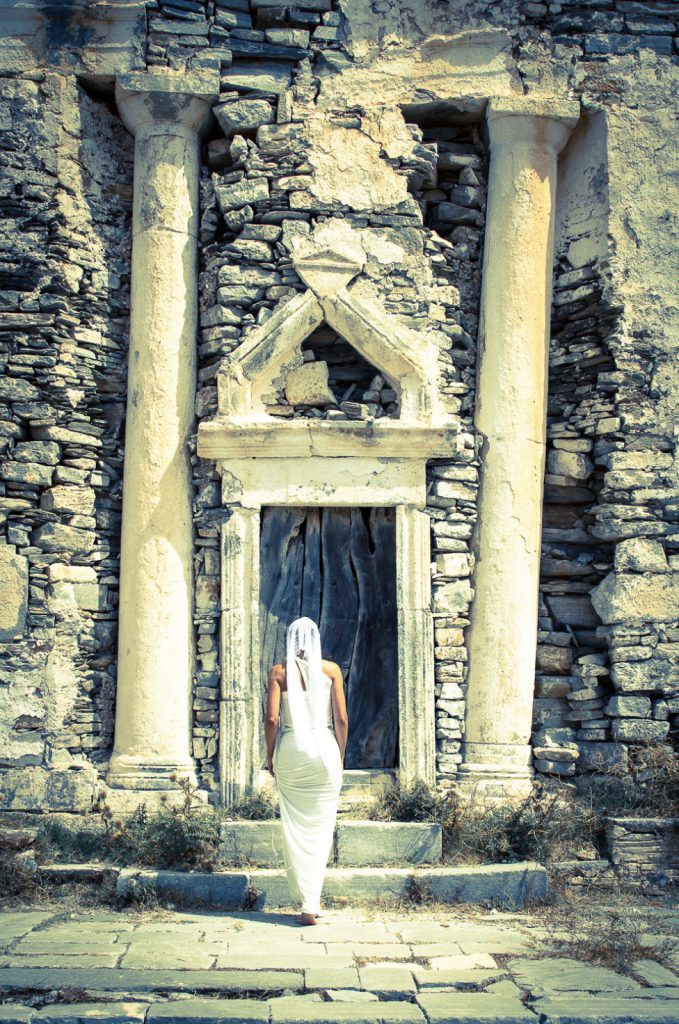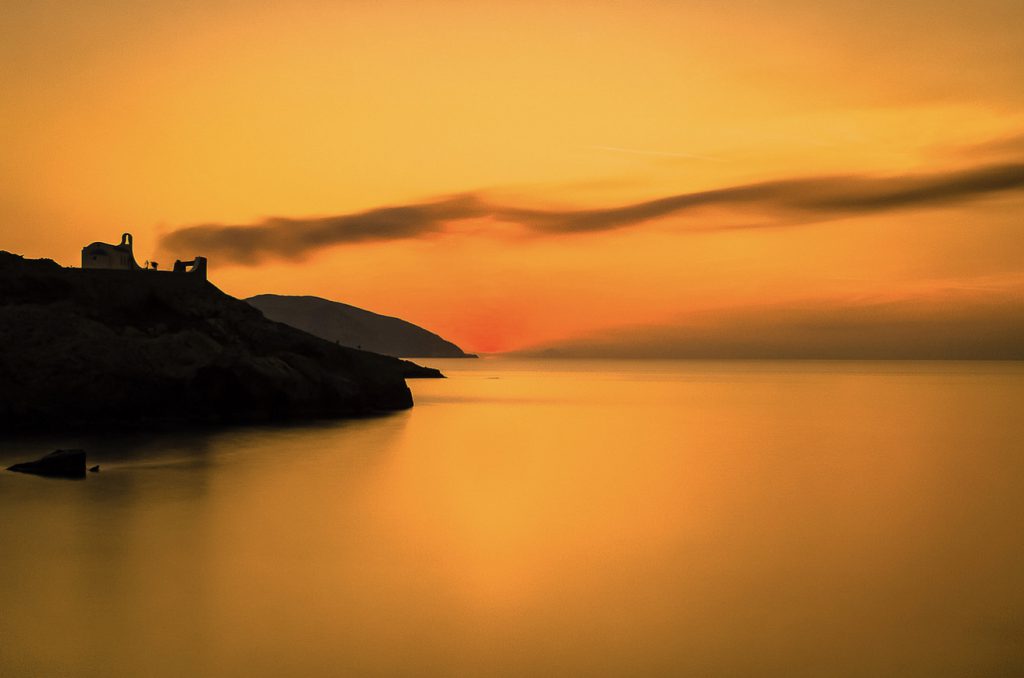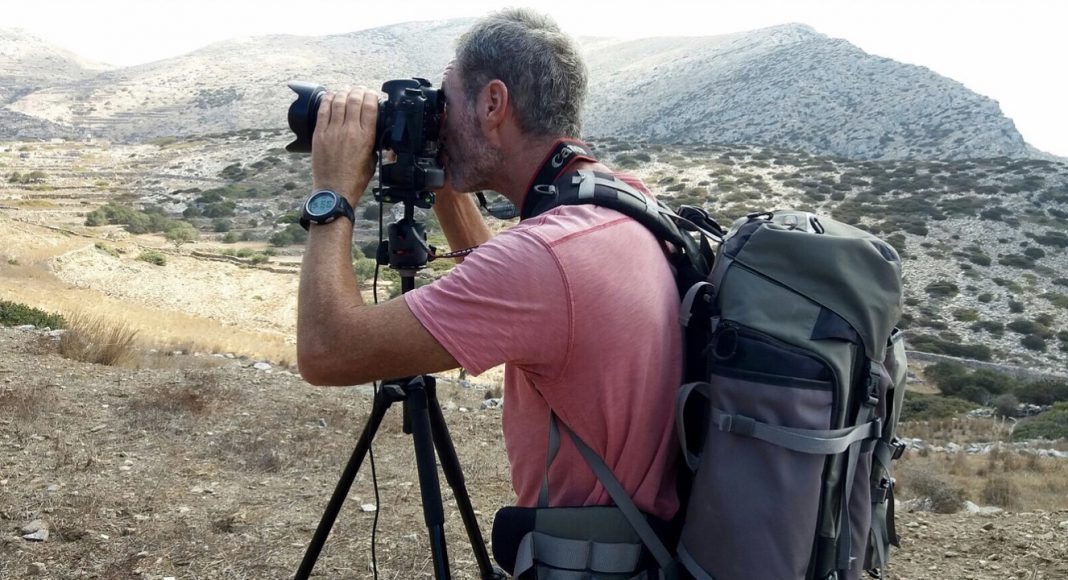Mark Wilman grew up in London’s Notting Hill area in the UK, to British parents with a Caribbean background. Starting from his childhood and spanning throughout his entire life, he found himself being constantly drawn back to Greece, particularly the Cyclades.
This commenced the journey that would see him dedicate his life’s work to photography projects in Greece. His most recent project being ‘Discovering the Beauty of the Cyclades‘, had a solo exhibition in Milan this year. The exhibition gained international recognition across Italy, Greece, Israel and more.
Mark discusses with us his intimate and authentic experiences in Greece that inspired him to share the beauty of the Cyclades, which he hopes “can help others look for and find a greater sense balance and peace” by immersing themselves in pure nature.
1. Why did you choose to focus your work on the Cyclades/Greece?
My first visit to the Cyclades was at the age of ten in 1974, with my parents and three younger sisters. A classmate in London was Greek and our parents became good friends. Also, a member of the British Sub Aqua Club, where my father was a director, was from Greece and they dived a lot together. Suddenly, we’d mostly be in the company of Hellenic people: Christenings at Saint Sophia Cathedral, the Greek Orthodox church in Moscow Road in the Bayswater area, parties and other social events. The Greek language became a familiar sound in our house. It was a special time for the family; my mother is from the Caribbean and she loved the festive atmosphere and exceptional flavours of the food we were all enjoying. At home, we’d eat Greek meals three times a week once the delicatessen near Saint Sophia was discovered.
Having experienced the beauty of the Cyclades that first year, we returned more times in the 1970s. Personally, I was amazed by the ever present blue sky, not a cloud in sight day after day, a miracle. I also loved the small, white hilltop houses, feta cheese, wild oregano and donkeys in the small streets whose owners wore shoes made from tyres.
As a young adult in the mid 80s, I visited again exploring the rugged landscapes and free-diving to the depths, as I’d learned to do in the Sub Aqua Club pool and with my father’s guidance in the Aegean a decade earlier.
I bought an inflatable boat and would travel with it from Milan, where I worked as a university lecturer and consultant particularly in the sectors of advertising, banking, fashion and law. The boat helped me discover the islands more completely above and below water, my profession permitted lengthy periods of holiday.
Each adventure had a story: battling 3 metre waves caused by ferocious Meltemi winds at dusk on return from far off free-diving explorations; the huge tuna that swam circles around me while groupers gazed up in amazement from their cave entrances far below; following steep goat paths for several kilometres to reach a historical mountain monastery where a yearly festival takes place. With the advent of digital cameras, describing these experiences to friends became more visual and interesting especially for those who’d never been to the islands, or even Greece.
I had the basic material in ideas to move forward with and actually create a project, though until the arrival of the woman who plays the role of the female in the work, I didn’t yet feel the impulse to start, the key was missing.
If the photos of undisturbed beauty in the Cyclades can help others look for and find a greater sense balance, peace, the desire to explore enhanced by exercise, and benefit from being more immersed in nature, I’d be most pleased.
2. How did Professor Angelos Delivorias influence your work?
I met the late Professor Angelos Delivorias, a prominent archeologist and director of the Benaki Museum in Athens for over forty years, in the late 1990s, the same year and in the same Cycladic Bay (one which Prime Minister Kostas Karamanlis also chose for his holidays), where I met a former U.S. President and future Secretary of State, were vacationing on a ship.
Meeting these men had a lasting impact on my approach to the project. Other than developing a sense of guidance and instinct regarding the islands’ historical past…it reinforced the idea that I could be heard at the top and taken seriously, encouraging the proposal of the work about the Cyclades, now in its sixth year, to art and cultural bodies of the highest level.
The Professor and I talked many times over two decades. For such a busy person, I appreciated the time he’d dedicate to my descriptions and impressions and his always useful answers…This new understanding furthered my desire to trek to more complex areas and dive deeper, my eye now recognising better what was on display in this immense natural museum. The rule of not touching what lay in its resting place I fully respected.

In July 2018, archeologists uncovered a tomb hidden under the church of Episkopi in a remote part of Sikinos. On its exterior was engraved the name Νεικω. It was dated back to the 3rd century A.D.
Two years earlier, I’d photographed the female figure in the project dressed in a classical white costume at the church…A long time after, reading about the discovery of the tomb felt wonderfully familiar; we’d anticipated an important historical discovery, a strange sensation on reflection. The title of that gallery, till then unpublished, became ‘Lost Lady of Sikinos, Neiko’.
The director of the Ephorate of Antiquities of the Cyclades found the photos very interesting.
3. Was there a purpose behind showing off Greece in Milan? How did the people of Milan react?
I began the project in June 2014, building a website some months later. The following year, metre long panoramic views were printed for a number of small exhibitions in various locations of a particular island. It was an opportunity to see if there was an artistic future; when I was five my teachers told my parents I was particularly arty, but only on that occasion!
In 2016, at the largest showing of the work, a retired couple from Milan, who were genuinely impressed by the display, insisted I should write to the Municipality and suggest the work for exhibition. This I did. Quite unexpectedly, a reply showing interest arrived soon after from the department of culture…The idea was presented to a specific committee who agreed on a public exhibition of the work, as a solo event, at the Aquarium close to the castle in the city centre.
Italians love Greece, particularly the Cyclades, so there was reason to believe the exhibition would be successful. With the dates confirmed several months before – May 9th to June 5th 2019 – preparation began in mid-winter. Finding a sponsor for the inauguration seemed a monumental task, until it wasn’t. The owner of a top Greek restaurant in Milan, Mykonos Taverna Greca, agreed to offer a buffet, which was thoroughly enjoyed by the many guests at the opening event.
People in Greece contacted me wanting to know specifics, while visitors to the exhibition wrote with enthusiasm.

4. What impact do you hope to achieve from your work? Particularly for Greece.
On my 50th birthday, a question came to mind: ‘What would I do if I were free to do anything, simply anything, without restrictions?‘
The answer that quickly spoke itself was, ‘photograph the Cyclades, no doubts.’
I’ve now done it, expressed what it was I’ve wanted to say and feel good about it. When, at times, I’ve contemplated letting go due to a lack of interest from outside, something has come along, lifted me up and encouraged its continuation, e.g. an art museum requesting a detailed presentation, or a cultural office interested to talk telephonically and later presenting the work to a superior board.
An ambassador said to me in a mail recently that the texts in the project are as valid as the photography, which was pleasantly surprising. It was never about taking pretty pictures to impress others with. Being there, loving life because those places were available to me in those moments is and was the point, sharing my impressions in the form of individual images each telling its own story has been my joy. If the photos of undisturbed beauty in the Cyclades can help others look for and find a greater sense balance, peace, the desire to explore enhanced by exercise, and benefit from being more immersed in nature, I’d be most pleased.
I was a teacher for many years and cared about the wellbeing of all my students, searching for ways to assist them in overcoming obstacles, obstacles in learning and those in their personal lives if necessary. I’d like to believe humankind can feel better about itself, do better, make better choices. Perhaps my photographic work and experiences can be inspiring in this sense.
The project has been proposed to UNESCO with the objective of helping conserve the archipelago for future generations. We should think about them more.
5. Is this a growing/continuing project? Do you have other plans for more work in Greece?
ANEK Lines, the historical Greek passenger and cargo shipping company, is a sponsor of further research of the project. Their trust is something I value decidedly. I hope other sponsors will follow.
At present, the islands included are: Anafi, Santorini (volcano and caldera), Ios, Sikinos, Folegandros, Poliegos, Kimolos, Milos, Sifnos, Serifos and Kythnos, each with its own intriguing personality. Exploration has been intense, done mostly on-foot covering great distances for many days at a time. I’ve enjoyed it a lot. 2020 could see a return to Amorgos, the Small Cyclades and Naxos.
I’ve also travelled extensively in other areas such as Crete, the Dodecanese, the Northeastern Aegean, the Sporades and Ionian islands as well as the Peloponnese. All of these would be potentially interesting subjects for future projects.
For more information on Mark’s projects head to his website http://www.markwilmanphotography.com/

